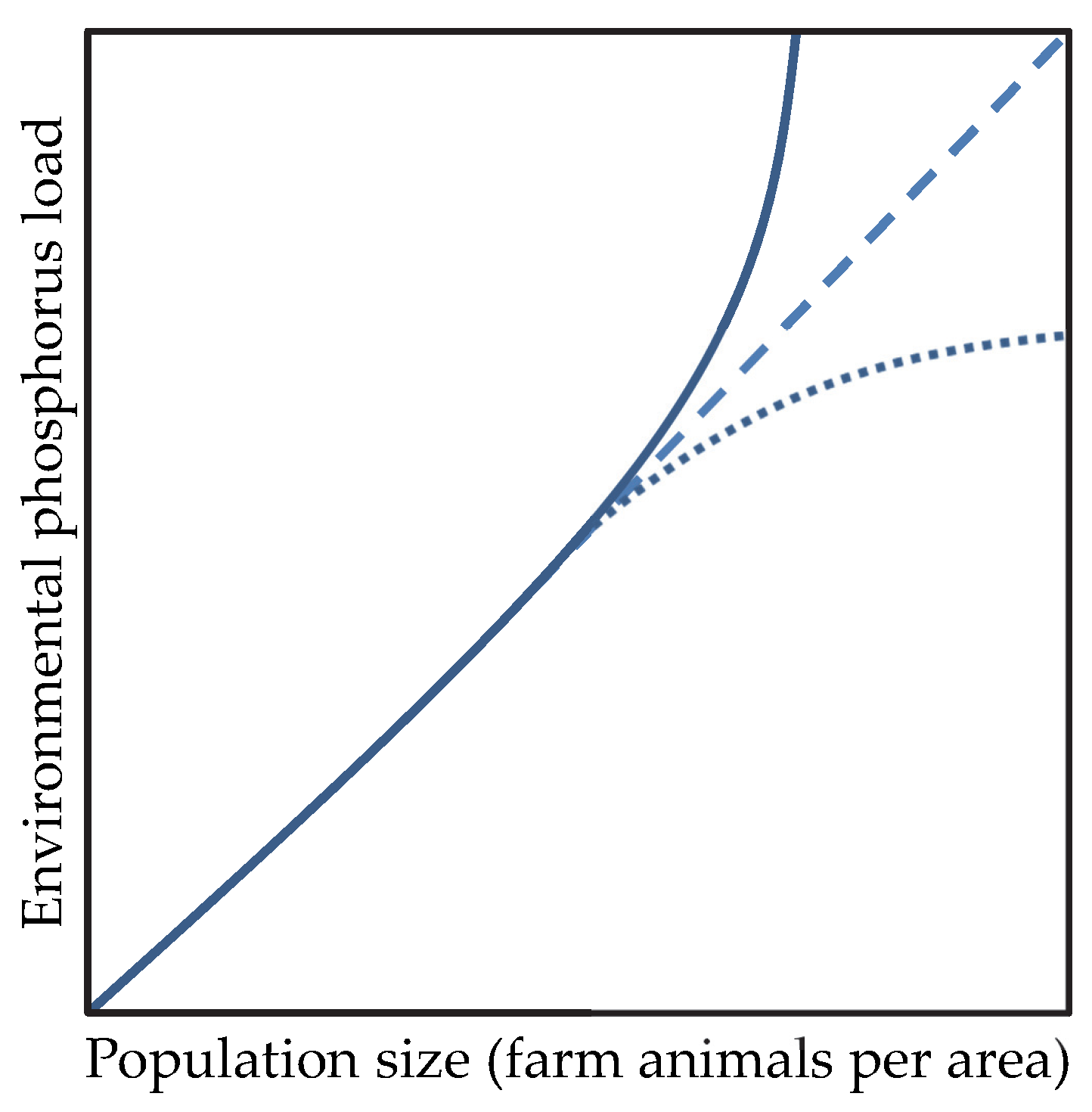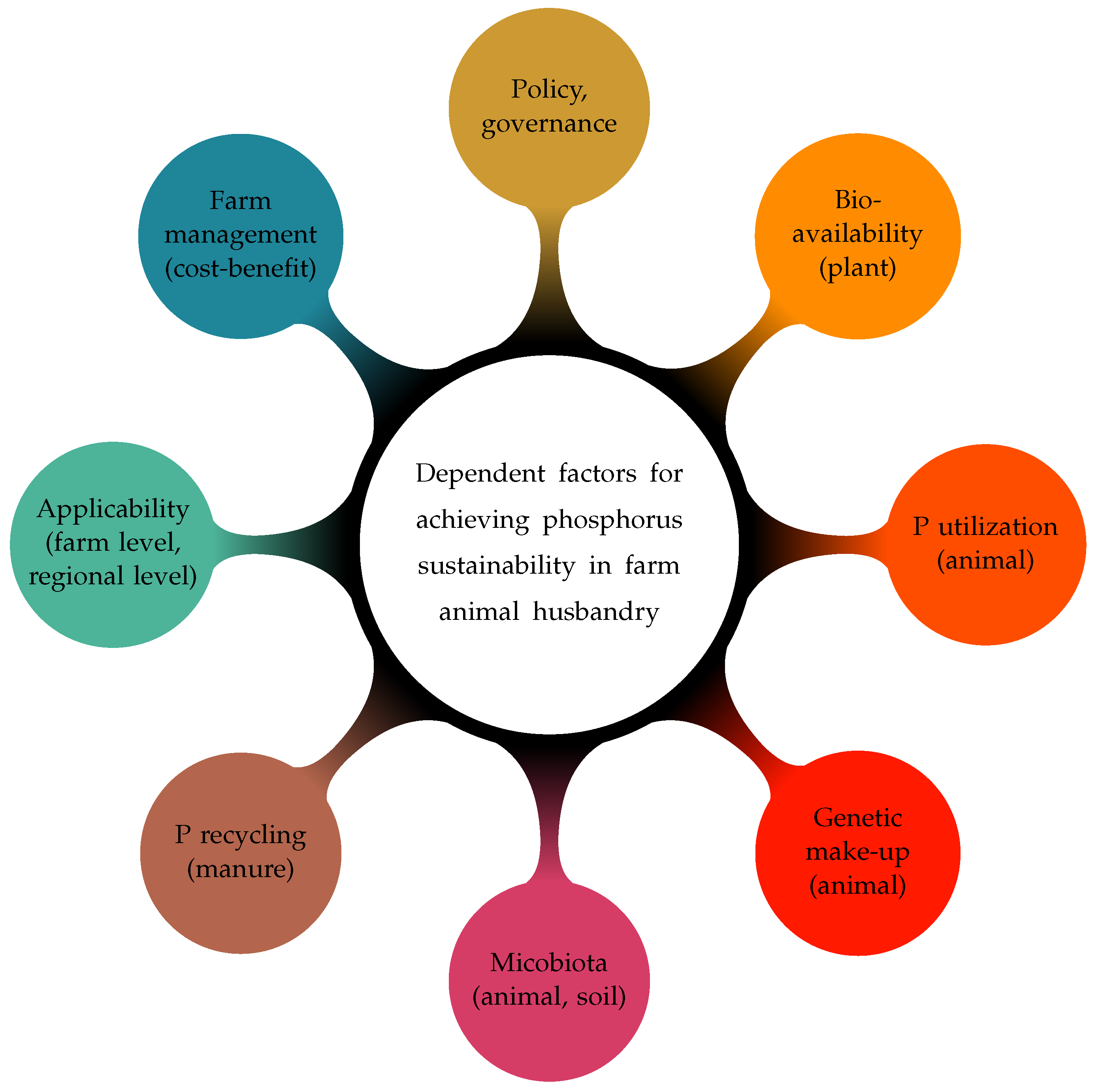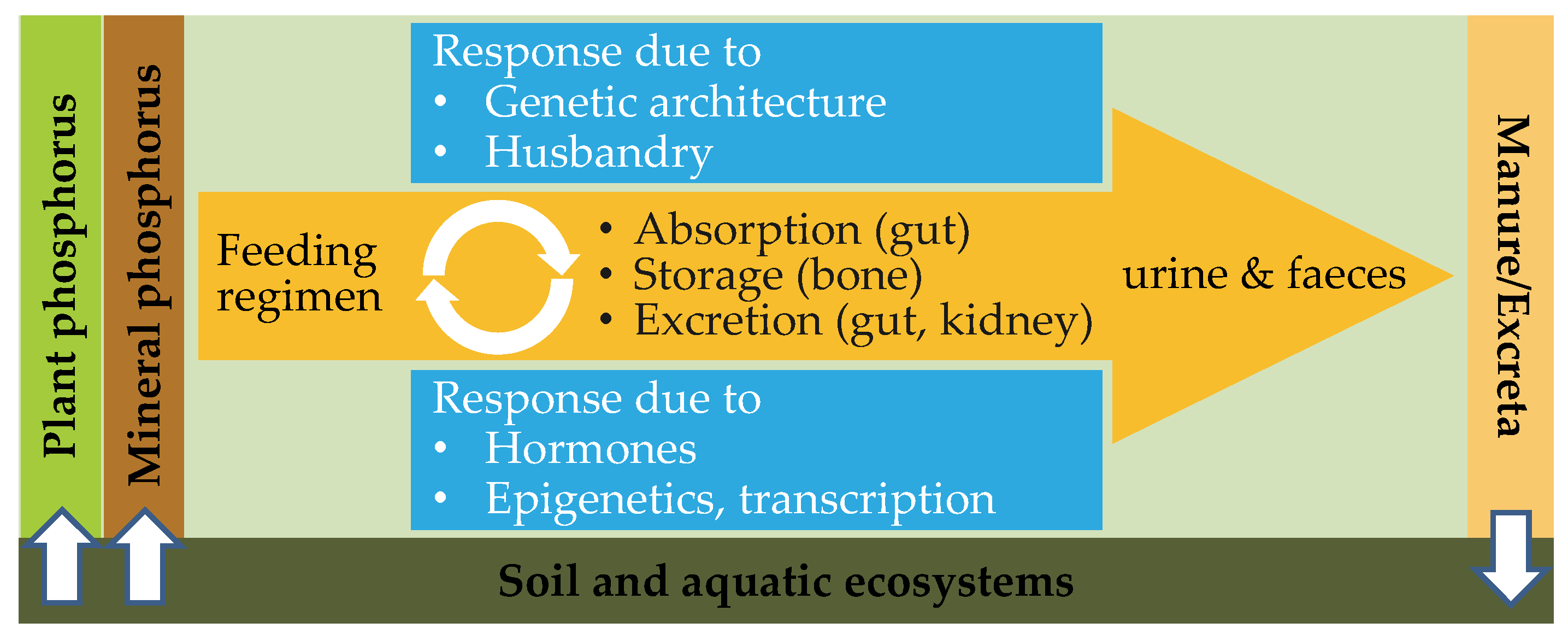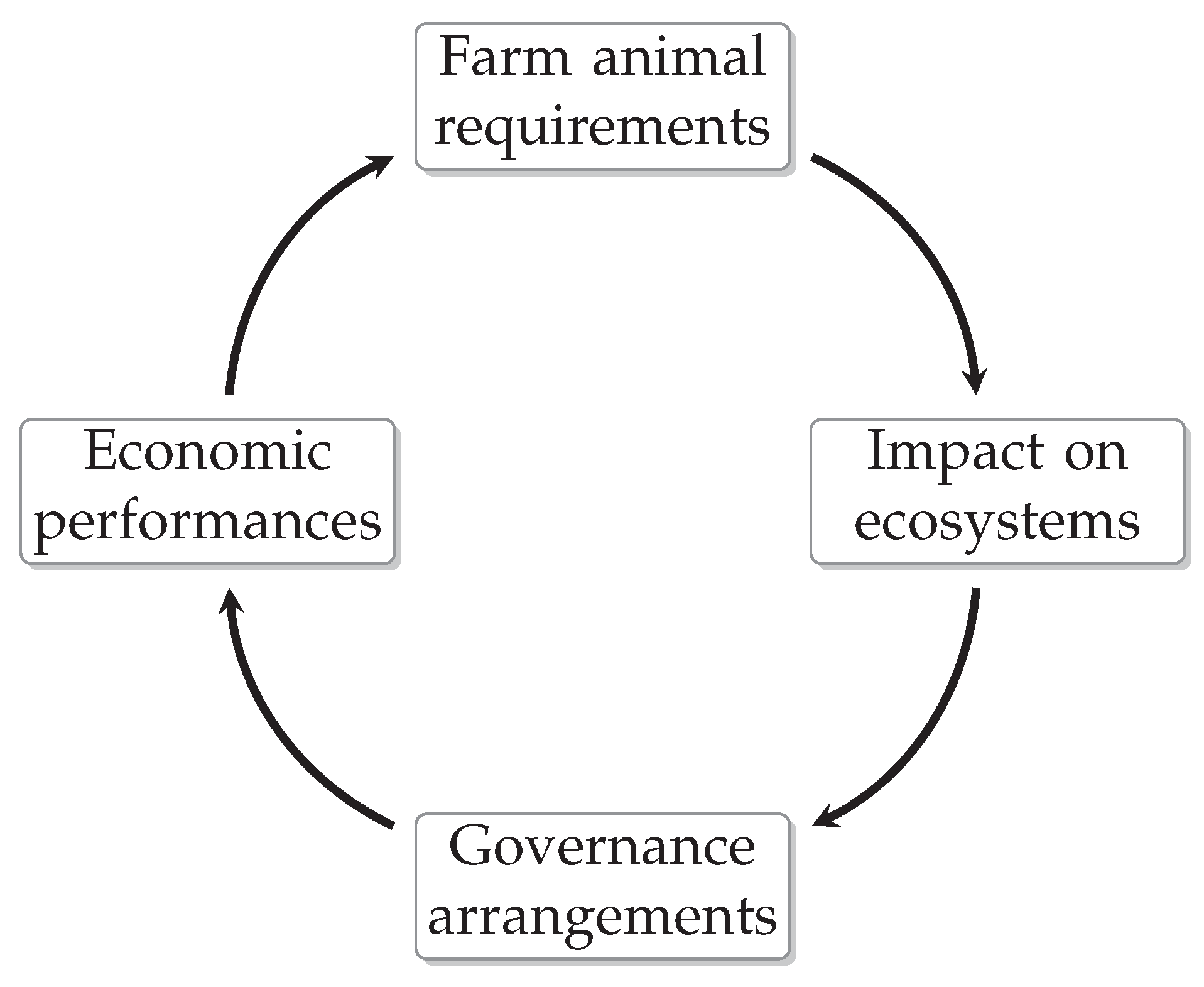Bridging Gaps in the Agricultural Phosphorus Cycle from an Animal Husbandry Perspective—The Case of Pigs and Poultry
Abstract
1. Introduction
2. Approaches to Achieving P Sustainability from an Animal Husbandry Perspective
2.1. Animal Nutrition
2.1.1. Feeding Regimen
2.1.2. Animal Welfare Aspects
2.1.3. Animal Genetics
2.2. Phosphorus Reuse and Recycling
2.3. Phosphorus Impact on Soil Agroecosystems
2.4. Policy and Governance
2.5. Farm Economics
3. Conclusions
Author Contributions
Funding
Conflicts of Interest
References
- Cordell, D.; White, S. Life’s bottleneck: Sustaining the world’s phosphorus for a food secure future. Annu. Rev. Environ. Resour. 2014, 39, 161–188. [Google Scholar] [CrossRef]
- Withers, P.; van Dijk, K.; Neset, T.; Nesme, T.; Oenema, O.; Rubæk, G.; Schoumans, O.; Smit, B.; Pellerin, S. Stewardship to tackle global phosphorus inefficiency: The case of Europe. Ambio 2015, 44 (Suppl. 2), S193–S206. [Google Scholar] [CrossRef] [PubMed]
- Yamaji, N.; Takemoto, Y.; Miyaji, T.; Mitani-Ueno, N.; Yoshida, K.; Ma, J. Reducing phosphorus accumulation in rice grains with an impaired transporter in the node. Nature 2017, 541, 92–95. [Google Scholar] [CrossRef] [PubMed]
- Sharpley, A.; Kleinman, P.; Jarvie, H.; Flaten, D. Distant views and local realities: The limits of global assessments to restore the fragmented phosphorus cycle. Agric. Environ. Lett. 2016, 1, 1–5. [Google Scholar] [CrossRef]
- Leinweber, P.; Bathmann, U.; Buczko, U.; Douhaire, C.; Eichler-Löbermann, B.; Frossard, E.; Ekardt, F.; Jarvie, H.; Krämer, I.; Kabbe, C.; et al. Handling the phosphorus paradox in agriculture and natural ecosystems: Scarcity, necessity, and burden of P. Ambio 2018, 47, 3–19. [Google Scholar] [CrossRef] [PubMed]
- Phosphate Rock. Mineral Commodity Summaries. U.S. Geological Survey. Available online: https://minerals.usgs.gov/minerals/pubs/commodity/phosphate_rock/mcs-2017-phosp.pdf (accessed on 10 April 2018).
- Rosemarin, A.; Ekane, N. The governance gap surrounding phosphorus. Nutr. Cycl. Agroecosyst. 2015, 104, 265–279. [Google Scholar] [CrossRef]
- Report on Critical Raw Materials for the EU. Available online: http://ec.europa.eu/DocsRoom/documents/10010/attachments/1/translations/en/renditions/native (accessed on 10 April 2018).
- Heckenmüller, M.; Narita, D.; Klepper, G. Global Availability of Phosphorus and Its Implications for Global Food Supply: An Economic Overview; Technical Report; Kiel Institute for the World Economy (IfW): Kiel, Germany, 2014; Available online: http://hdl.handle.net/10419/90630 (accessed on 10 April 2018).
- Cordell, D.; Drangert, J.; White, S. The story of phosphorus: Global food security and food for thought. Glob. Environ. Chang. 2009, 19, 292–305. [Google Scholar] [CrossRef]
- Schröder, J.; Cordell, D.; Smit, A.; Rosemarin, A. Sustainable use of Phosphorus, Report 357; Plant Research Institute, Wageningen University: Wageningen, The Netherlands; Stockholm Environment Institute: Stockholm, Sweden, 2010. [Google Scholar]
- MacDonald, G.; Bennett, E.; Carpenter, S. Embodied phosphorus and the global connections of United States agriculture. Environ. Res. Lett. 2012, 7, 044024. [Google Scholar] [CrossRef]
- Ddiba, D. Estimating the Potential for Resource Recovery from Productive Sanitation in Urban Areas; KTH Royal, Institute of Technology: Stockholm, Sweden, 2016. [Google Scholar]
- Poulsen, H.; Jongbloed, A.; Latimier, P.; Fernández, J. Phosphorus consumption, utilisation and losses in pig production in France, The Netherlands and Denmark. Livest. Prod. Sci. 1999, 58, 251–259. [Google Scholar] [CrossRef]
- Barnett, G. Phosphorus forms in animal manure. Bioresour. Technol. 1994, 49, 139–147. [Google Scholar] [CrossRef]
- Steinfeld, H.; Gerber, P.; Wassenaar, T.; Castel, V.; De Haan, C. Livestock’s Long Shadow: Environmental Issues and Options; Food & Agriculture Org: Rome, Italy, 2006. [Google Scholar]
- Cordell, D.; White, S. Sustainable Phosphorus Measures: Strategies and Technologies for Achieving Phosphorus Security. Agronomy 2013, 3, 86–116. [Google Scholar] [CrossRef]
- Campbell, B.; Beare, D.; Bennett, E.; Hall-Spencer, J.; Ingram, J.; Jaramillo, F.; Ortiz, R.; Ramankutty, N.; Sayer, J.; Shindell, D. Agriculture production as a major driver of the Earth system exceeding planetary boundaries. Ecol. Soc. 2017, 22, 8. [Google Scholar] [CrossRef]
- Ritchie, H.; Roser, M. Meat and Seafood Production & Consumption. Available online: https://ourworldindata.org/meat-and-seafood-production-consumption (accessed on 10 April 2018).
- Berndt, T.; Kumar, R. Novel mechanisms in the regulation of phosphorus homeostasis. Physiology 2009, 24, 17–25. [Google Scholar] [CrossRef] [PubMed]
- Mieczkowska, A.; Irwin, N.; Flatt, P.; Chappard, D.; Mabilleau, G. Glucose-dependent insulinotropic polypeptide (GIP) receptor deletion leads to reduced bone strength and quality. Bone 2013, 56, 337–342. [Google Scholar] [CrossRef] [PubMed]
- Pi, M.; Quarles, L. Novel bone endocrine networks integrating mineral and energy metabolism. Curr. Osteoporos. Rep. 2013, 11, 391–399. [Google Scholar] [CrossRef] [PubMed]
- Alshayeb, H.; Showkat, A.; Wall, B.; Gyamlani, G.; David, V.; Quarles, L. Activation of FGF-23 mediated vitamin D degradative pathways by cholecalciferol. J. Clin. Endocrinol. Metab. 2014, 99, E1830–E1837. [Google Scholar] [CrossRef] [PubMed][Green Version]
- Proszkowiec-Weglarz, M.; Angel, R. Calcium and phosphorus metabolism in broilers: Effect of homeostatic mechanism on calcium and phosphorus digestibility. J. Appl. Poult. Res. 2013, 22, 609–627. [Google Scholar] [CrossRef]
- Oster, M.; Gerlinger, C.; Heide, K.; Just, F.; Borgelt, L.; Wolf, P.; Polley, C.; Vollmar, B.; Muráni, E.; Ponsuksili, S.; et al. Lower dietary phosphorus supply in pigs match both animal welfare aspects and resource efficiency. Ambio 2018, 47 (Suppl. 1), 20–29. [Google Scholar] [CrossRef] [PubMed]
- Morito, N.; Yoh, K.; Usui, T.; Oishi, H.; Ojima, M.; Fujita, A.; Koshida, R.; Shawki, H.; Hamada, M.; Muratani, M.; et al. Transcription factor MafB may play an important role in secondary hyperparathyroidism. Kidney Int. 2018, 93, 54–68. [Google Scholar] [CrossRef] [PubMed]
- Bovo, S.; Schiavo, G.; Mazzoni, G.; Dall’Olio, S.; Galimberti, G.; Calò, D.; Scotti, E.; Bertolini, F.; Buttazzoni, L.; Samorè, A.; et al. Genome-wide association study for the level of serum electrolytes in Italian Large White pigs. Anim. Genet. 2016, 47, 597–602. [Google Scholar] [CrossRef] [PubMed]
- Just, F.; Oster, M.; Büsing, K.; Borgelt, L.; Murani, E.; Ponsuksili, S.; Wolf, P.; Wimmers, K. Lowered dietary phosphorus affects intestinal and renal gene expression to maintain mineral homeostasis with immunomodulatory implications in weaned piglets. BMC Genom. 2018, 19, 207. [Google Scholar] [CrossRef] [PubMed]
- Pomar, C.; Hauschild, L.; Zhang, G.; Pomar, J.; Lovatto, P. Applying precision feeding techniques in growing-finishing pig operations. Revista Brasileira de Zootecnia 2009, 38, 226–237. [Google Scholar] [CrossRef]
- Poulsen, H. Normtal for HusdyrgøDning [Standard Values for Danish Manure]. Available online: http://anis.au.dk/fileadmin/DJF/Anis/dokumenter_anis/Forskning/Normtal/Normtal_2017.pdf (accessed on 10 April 2018).
- Valable, A.; Narcy, A.; Duclos, M.; Pomar, C.; Page, G.; Nasir, Z.; Magnin, M.; Létourneau-Montminy, M. Effects of dietary calcium and phosphorus deficiency and subsequent recovery on broiler chicken growth performance and bone characteristics. Animal 2017, 1–9. [Google Scholar] [CrossRef] [PubMed]
- Gonzalo, E.; Létourneau-Montminy, M.; Narcy, A.; Bernier, J.; Pomar, C. Consequences of dietary calcium and phosphorus depletion and repletion feeding sequences on growth performance and body composition of growing pigs. Animal 2018, 12, 1165–1173. [Google Scholar] [CrossRef] [PubMed]
- Hales, C.; Barker, D.; Clark, P.; Cox, L.; Fall, C.; Osmond, C.; Winter, P. Fetal and infant growth and impaired glucose tolerance at age 64. BMJ 1991, 303, 1019–1022. [Google Scholar] [CrossRef] [PubMed]
- Howie, G.; Sloboda, D.; Kamal, T.; Vickers, M. Maternal nutritional history predicts obesity in adult offspring independent of postnatal diet. J. Physiol. 2009, 587, 905–915. [Google Scholar] [CrossRef] [PubMed]
- Rehfeldt, C.; Lang, I.; Goers, S.; Hennig, U.; Kalbe, C.; Stabenow, B.; Bruessow, K.; Pfuhl, R.; Bellmann, O.; Nuernberg, G.; et al. Low and excess dietary protein levels during gestation affect growth and compositional traits in gilts and impair offspring fetal growth. J. Anim. Sci. 2011, 89, 329–341. [Google Scholar] [CrossRef] [PubMed]
- Ojha, S.; Fainberg, H.; Sebert, S.; Budge, H.; Symonds, M. Maternal health and eating habits: Metabolic consequences and impact on child health. Trends Mol. Med. 2015, 21, 126–133. [Google Scholar] [CrossRef] [PubMed]
- Fleming, T.; Watkins, A.; Velazquez, M.; Mathers, J.; Prentice, A.M.; Stephenson, J.; Barker, M.; Saffery, R.; Yajnik, C.; Eckert, J.; et al. Origins of lifetime health around the time of conception: Causes and consequences. Lancet 2018, 391, 1842–1852. [Google Scholar] [CrossRef]
- Wolff, G.; Kodell, R.; Moore, S.; Cooney, C. Maternal epigenetics and methyl supplements affect agouti gene expression in Avy/a mice. FASEB J. 1998, 12, 949–957. [Google Scholar] [CrossRef] [PubMed]
- Sebert, S.; Sharkey, D.; Budge, H.; Symonds, M. The early programming of metabolic health: Is epigenetic setting the missing link? Am. J. Clin. Nutr. 2011, 94 (Suppl. 6), 1953S–1958S. [Google Scholar] [CrossRef] [PubMed]
- Bateson, P.; Barker, D.; Clutton-Brock, T.; Deb, D.; D’Udine, B.; Foley, R.; Gluckman, P.; Godfrey, K.; Kirkwood, T.; Lahr, M.; et al. Developmental plasticity and human health. Nature 2004, 430, 419–421. [Google Scholar] [CrossRef] [PubMed]
- Ashwell, C.; Angel, R. Nutritional genomics: A practical approach by early life conditioning with dietary phosphorus. Revista Brasileira de Zootecnia 2010, 39, 268–278. [Google Scholar] [CrossRef]
- McHardy, G.; Parsons, D. The absorption of inorganic phosphate from the small intestine of the rat. Exp. Physiol. 1956, 41, 398–409. [Google Scholar] [CrossRef]
- Blaabjerg, K.; Jørgensen, H.; Tauson, A.; Poulsen, H. Heat-treatment, phytase and fermented liquid feeding affect the presence of inositol phosphates in ileal digesta and phosphorus digestibility in pigs fed a wheat and barley diet. Animal 2010, 4, 876–885. [Google Scholar] [CrossRef] [PubMed]
- Metzler-Zebeli, B.; Molnár, A.; Hollmann, M.; Magowan, E.; Hawken, R.; Lawlor, P.; Zebeli, Q. Comparison of growth performance and excreta composition in broiler chickens when ranked according to various feed efficiency metrics. J. Anim. Sci. 2016, 94, 2890–2899. [Google Scholar] [CrossRef] [PubMed]
- McCormack, U.; Curião, T.; Buzoianu, S.; Prieto, M.; Ryan, T.; Varley, P.; Crispie, F.; Magowan, E.; Metzler-Zebeli, B.; Berry, D. Exploring a possible link between the intestinal microbiota and feed efficiency in pigs. Appl. Environ. Microbiol. 2017, 83, e00380-17. [Google Scholar] [CrossRef] [PubMed]
- Sjöberg, P.; Thelin, P.; Rydin, E. Separation of inositol phosphate isomers in environmental samples by ion-exchange chromatography coupled with electrospray ionization tandem mass spectrometry. Talanta 2016, 161, 392–397. [Google Scholar] [CrossRef] [PubMed]
- Brady, S.; Callan, J.; Cowan, D.; McGrane, M.; O’Doherty, J. Effect of phytase inclusion and calcium/phosphorus ratio on the performance and nutrient retention of grower–finisher pigs fed barley/wheat/soya bean meal-based diets. J. Sci. Food Agric. 2002, 82, 1780–1790. [Google Scholar] [CrossRef]
- Huber, K.; Zeller, E.; Rodehutscord, M. Modulation of small intestinal phosphate transporter by dietary supplements of mineral phosphorus and phytase in broilers. Poult. Sci. 2015, 94, 1009–1017. [Google Scholar] [CrossRef] [PubMed]
- Dersjant-Li, Y.; Awati, A.; Schulze, H.; Partridge, G. Phytase in non-ruminant animal nutrition: A critical review on phytase activities in the gastrointestinal tract and influencing factors. J. Sci. Food Agric. 2015, 95, 878–896. [Google Scholar] [CrossRef] [PubMed]
- Golovan, S.; Meidinger, R.; Ajakaiye, A.; Cottrill, M.; Wiederkehr, M.; Barney, D.; Plante, C.; Pollard, J.; Fan, M.; Hayes, M.; et al. Pigs expressing salivary phytase produce low-phosphorus manure. Nat. Biotechnol. 2001, 19, 741–745. [Google Scholar] [CrossRef] [PubMed]
- Cramer, C. Aspects of intestinal absorption of Ca, P and Mg. Methods Achiev. Exp. Pathol. 1972, 6, 172–192. [Google Scholar]
- Oster, M.; Nuchchanart, W.; Trakooljul, N.; Murani, E.; Zeyner, A.; Wirthgen, E.; Hoeflich, A.; Ponsuksili, S.; Wimmers, K. Methylating micronutrient supplementation during pregnancy influences foetal hepatic gene expression and IGF signalling and increases foetal weight. Eur. J. Nutr. 2016, 55, 1717–1727. [Google Scholar] [CrossRef] [PubMed]
- Letourneau-Montminy, M.; Narcy, A.; Dourmad, J.; Crenshaw, T.; Pomar, C. Modeling the metabolic fate of dietary phosphorus and calcium and the dynamics of body ash content in growing pigs. J. Anim. Sci. 2015, 93, 1200–1217. [Google Scholar] [CrossRef] [PubMed]
- Nicodemo, M.; Scott, D.; Buchan, W.; Duncan, A.; Robins, S. Effects of variations in dietary calcium and phosphorus supply on plasma and bone osteocalcin concentrations and bone mineralization in growing pigs. Exp. Physiol. 1998, 83, 659–665. [Google Scholar] [CrossRef] [PubMed]
- Liesegang, A.; Ursprung, R.; Gasser, J.; Sassi, M.; Risteli, J.; Riond, J.; Wanner, M. Influence of dietary phosphorus deficiency with or without addition of fumaric acid to a diet in pigs on bone parameters. J. Anim. Physiol. Anim. Nutr. 2002, 86, 1–16. [Google Scholar] [CrossRef]
- Sørensen, K.; Tauson, A.; Poulsen, H. Long term differentiated phosphorus supply from below to above requirement affects nutrient balance and retention, body weight gain and bone growth in growing-finishing pigs. Livest. Sci. 2018, 211, 14–20. [Google Scholar] [CrossRef]
- Heyer, C.; Weiss, E.; Schmucker, S.; Rodehutscord, M.; Hoelzle, L.; Mosenthin, R.; Stefanski, V. The impact of phosphorus on the immune system and the intestinal microbiota with special focus on the pig. Nutr. Res. Rev. 2015, 28, 67–82. [Google Scholar] [CrossRef] [PubMed]
- Kegley, E.; Spears, J.; Auman, S. Dietary phosphorus and an inflammatory challenge affect performance and immune function of weanling pigs. J. Anim. Sci. 2001, 79, 413–419. [Google Scholar] [CrossRef] [PubMed]
- Takayanagi, H. Osteoimmunology: Shared mechanisms and crosstalk between the immune and bone systems. Nat. Rev. Immunol. 2007, 7, 292–304. [Google Scholar] [CrossRef] [PubMed]
- Okamoto, K.; Nakashima, T.; Shinohara, M.; Negishi-Koga, T.; Komatsu, N.; Terashima, A.; Sawa, S.; Nitta, T.; Takayanagi, H. Osteoimmunology: The conceptual framework unifying the immune and skeletal systems. Physiol. Rev. 2017, 97, 1295–1349. [Google Scholar] [CrossRef] [PubMed]
- Ankra-Badu, G.; Pesti, G.; Aggrey, S. Genetic interrelationships among phosphorus, nitrogen, calcium, and energy bioavailability in a growing chicken population. Poult. Sci. 2010, 89, 2351–2355. [Google Scholar] [CrossRef] [PubMed]
- Beck, P.; Piepho, H.; Rodehutscord, M.; Bennewitz, J. Inferring relationships between Phosphorus utilization, feed per gain, and bodyweight gain in an F2 cross of Japanese quail using recursive models. Poult. Sci. 2016, 95, 764–773. [Google Scholar] [CrossRef] [PubMed]
- Beck, P.; Stratz, P.; Preuß, S.; Pitel, F.; Recoquillay, J.; Duval, E.; Rodehutscord, M.; Bennewitz, J. Linkage mapping of quantitative trait loci for phosphorus utilization and growth related traits in an F2-cross of Japanese quail (Coturnix japonica). Eur. Poult. Sci. 2016, 80. [Google Scholar] [CrossRef]
- Alexander, L.; Qu, A.; Cutler, S.; Mahajan, A.; Lonergan, S.; Rothschild, M.; Weber, T.; Kerr, B.; Stahl, C. Response to dietary phosphorus deficiency is affected by genetic background in growing pigs. J. Anim. Sci. 2008, 86, 2585–2595. [Google Scholar] [CrossRef] [PubMed]
- Rothammer, S.; Bernau, M.; Kremer-Rücker, P.V.; Medugorac, I.; Scholz, A.M. Genome-wide QTL mapping results for regional DXA body composition and bone mineral density traits in pigs. Arch. Anim. Breed. 2017, 60, 51–59. [Google Scholar] [CrossRef]
- Zhang, W.; Aggrey, S.; Pesti, G.; Edwards, H., Jr.; Bakalli, R. Genetics of phytate phosphorus bioavailability: Heritability and genetic correlations with growth and feed utilization traits in a randombred chicken population. Poult. Sci. 2003, 82, 1075–1079. [Google Scholar] [CrossRef] [PubMed]
- Ponsuksili, S.; Trakooljul, N.; Hadlich, F.; Haack, F.; Murani, E.; Wimmers, K. Genetically regulated hepatic transcripts and pathways orchestrate haematological, biochemical and body composition traits. Sci. Rep. 2016, 6, 39614. [Google Scholar] [CrossRef] [PubMed]
- Ponsuksili, S.; Trakooljul, N.; Hadlich, F.; Haack, F.; Murani, E.; Wimmers, K. Genetic architecture and regulatory impact on hepatic microRNA expression linked to immune and metabolic traits. Open Biol. 2017, 7, 170101. [Google Scholar] [CrossRef] [PubMed]
- Meat Production Statistics—Statistics Explained. Available online: http://ec.europa.eu/eurostat/statisticsexplained/index.php/Meat_production_statistics#Poultry_meat (accessed on 10 April 2018).
- Pork Production up in the EU—Product—Eurostat. Available online: http://ec.europa.eu/eurostat/en/web/products-eurostat-news/-/DDN-20170919-1 (accessed on 10 April 2018).
- Foged, H.; Flotats, X.; Blasi, A.; Palatsi, J.; Magri, A.; Schelde, K. Inventory of Manure Processing Activities in Europe. Available online: https://upcommons.upc.edu/bitstream/handle/2117/18943/21010_technical_report_I_inventory.pdf?sequence=1&isAllowed=y (accessed on 10 April 2018).
- Helsinki-Commission. HELCOM Baltic Sea Action Plan; HELCOM Ministerial Meeting: Krakow, Poland, 2007. [Google Scholar]
- Aloe, A.; Bouraoui, F.; Grizzetti, B.; Bidoglio, G.; Pistocchi, A. Managing Nitrogen and Phosphorous Loads to Water Bodies: Characterizations and Solutions; European Commission, Joint Research Centre, Institute for Environment and Sustainability: Ispra, Italy, 2014. [Google Scholar]
- Połtowicz, K.; Doktor, J. Effect of free-range raising on performance, carcass attributes and meat quality of broiler chickens. Anim. Sci. Pap. Rep. 2011, 29, 139–149. [Google Scholar]
- Verheijen, L.; Wiersema, D.; Hulshoff Pol, L.; De Wit, L. Livestock and the Environment: Finding a Balance: Management of Waste from Animal Product Processing; International Agricultural Centre (IAC): Wageningen, The Netherlands, 1996. [Google Scholar]
- Lessler, J.; Ranells, N. Grower Guidelines for Poultry and Fowl Processing; North Carolina State University Cooperative Extension: Raleigh, NC, USA, 2007. [Google Scholar]
- McCrackin, M.L.; Gustafsson, B.; Hong, B.; Howarth, R.; Humborg, C.; Savchuk, O.; Svanbäck, A.; Swaney, D. Opportunities to reduce nutrient inputs to the Baltic Sea by improving manure use efficiency in agriculture. Reg. Environ. Chang. 2018, 1–12. [Google Scholar] [CrossRef]
- Lebuf, V.; Accoe, F.; Van Elsacker, S.; Vaneeckhaute, C.; Michels, E.; Meers, E.; Ghekiere, G.; Ryckaert, B. Techniques for Nutrient Recovery From Digestate: Inventory. Available online: https://biblio.ugent.be/publication/7010573 (accessed on 10 April 2018).
- Vaneeckhaute, C.; Lebuf, V.; Michels, E.; Belia, E.; Vanrolleghem, P.; Tack, F.; Meers, E. Nutrient recovery from digestate: Systematic technology review and product classification. Waste Biomass Valorization 2017, 8, 21–40. [Google Scholar] [CrossRef]
- Yue, K.; Yang, W.; Peng, Y.; Peng, C.; Tan, B.; Xu, Z.; Zhang, L.; Ni, X.; Zhou, W.; Wu, F. Individual and combined effects of multiple global change drivers on terrestrial phosphorus pools: A meta-analysis. Sci. Total Environ. 2018, 630, 181–188. [Google Scholar] [CrossRef] [PubMed]
- Turner, B.; Frossard, E.; Baldwin, D. (Eds.) Organic Phosphorus in the Environment; CABI International: Wallingford, UK, 2005. [Google Scholar]
- Ackerly, D.; Stuart, S. Physiological Ecology: Plants. In The Princeton Guide to Ecology; Princeton University Press: Woodstock, UK, 2009. [Google Scholar]
- Schindler, D.; Vallentyne, J. The Algal Bowl: Over Fertilization of the World’s Freshwaters and Estuaries; University of Alberta Press: Edmonton, AB, Canada, 2008. [Google Scholar]
- Ceulemans, T.; Stevens, C.; Duchateau, L.; Jacquemyn, H.; Gowing, D.; Merckx, R.; Wallace, H.; van Rooijen, N.; Goethem, T.; Bobbink, R.; et al. Soil phosphorus constrains biodiversity across European grasslands. Glob. Chang. Biol. 2014, 20, 3814–3822. [Google Scholar] [CrossRef] [PubMed]
- Rillig, M. Arbuscular mycorrhizae and terrestrial ecosystem processes. Ecol. Lett. 2004, 7, 740–754. [Google Scholar] [CrossRef]
- Isbell, F.; Adler, P.; Eisenhauer, N.; Fornara, D.; Kimmel, K.; Kremen, C.; Letourneau, D.; Liebman, M.; Polley, H.; Quijas, S.; et al. Benefits of increasing plant diversity in sustainable agroecosystems. J. Ecol. 2017, 105, 871–879. [Google Scholar] [CrossRef]
- Garnache, C.; Swinton, S.; Herriges, J.; Lupi, F.; Stevenson, R. Solving the phosphorus pollution puzzle: Synthesis and directions for future research. Am. J. Agric. Econ. 2016, 98, 1334–1359. [Google Scholar] [CrossRef]
- Goff, J. Invited review: Mineral absorption mechanisms, mineral interactions that affect acid–base and antioxidant status, and diet considerations to improve mineral status. J. Dairy Sci. 2018, 101, 2763–2813. [Google Scholar] [CrossRef] [PubMed]
- Janssen, S.; Van Ittersum, M.K. Assessing farm innovations and responses to policies: A review of bio-economic farm models. Agric. Syst. 2007, 94, 622–636. [Google Scholar] [CrossRef]
- Louhichi, K.; Kanellopoulos, A.; Janssen, S.; Flichman, G.; Blanco, M.; Hengsdijk, H.; Heckelei, T.; Berentsen, P.; Lansink, A.; Van Ittersum, M. FSSIM, a bio-economic farm model for simulating the response of EU farming systems to agricultural and environmental policies. Agric. Syst. 2010, 103, 585–597. [Google Scholar] [CrossRef]
- Belhouchette, H.; Louhichi, K.; Therond, O.; Mouratiadou, I.; Wery, J.; Van Ittersum, M.; Flichman, G. Assessing the impact of the Nitrate Directive on farming systems using a bio-economic modelling chain. Agric. Syst. 2011, 104, 135–145. [Google Scholar] [CrossRef]




© 2018 by the authors. Licensee MDPI, Basel, Switzerland. This article is an open access article distributed under the terms and conditions of the Creative Commons Attribution (CC BY) license (http://creativecommons.org/licenses/by/4.0/).
Share and Cite
Oster, M.; Reyer, H.; Ball, E.; Fornara, D.; McKillen, J.; Sørensen, K.U.; Poulsen, H.D.; Andersson, K.; Ddiba, D.; Rosemarin, A.; et al. Bridging Gaps in the Agricultural Phosphorus Cycle from an Animal Husbandry Perspective—The Case of Pigs and Poultry. Sustainability 2018, 10, 1825. https://doi.org/10.3390/su10061825
Oster M, Reyer H, Ball E, Fornara D, McKillen J, Sørensen KU, Poulsen HD, Andersson K, Ddiba D, Rosemarin A, et al. Bridging Gaps in the Agricultural Phosphorus Cycle from an Animal Husbandry Perspective—The Case of Pigs and Poultry. Sustainability. 2018; 10(6):1825. https://doi.org/10.3390/su10061825
Chicago/Turabian StyleOster, Michael, Henry Reyer, Elizabeth Ball, Dario Fornara, John McKillen, Kristina Ulrich Sørensen, Hanne Damgaard Poulsen, Kim Andersson, Daniel Ddiba, Arno Rosemarin, and et al. 2018. "Bridging Gaps in the Agricultural Phosphorus Cycle from an Animal Husbandry Perspective—The Case of Pigs and Poultry" Sustainability 10, no. 6: 1825. https://doi.org/10.3390/su10061825
APA StyleOster, M., Reyer, H., Ball, E., Fornara, D., McKillen, J., Sørensen, K. U., Poulsen, H. D., Andersson, K., Ddiba, D., Rosemarin, A., Arata, L., Sckokai, P., Magowan, E., & Wimmers, K. (2018). Bridging Gaps in the Agricultural Phosphorus Cycle from an Animal Husbandry Perspective—The Case of Pigs and Poultry. Sustainability, 10(6), 1825. https://doi.org/10.3390/su10061825





